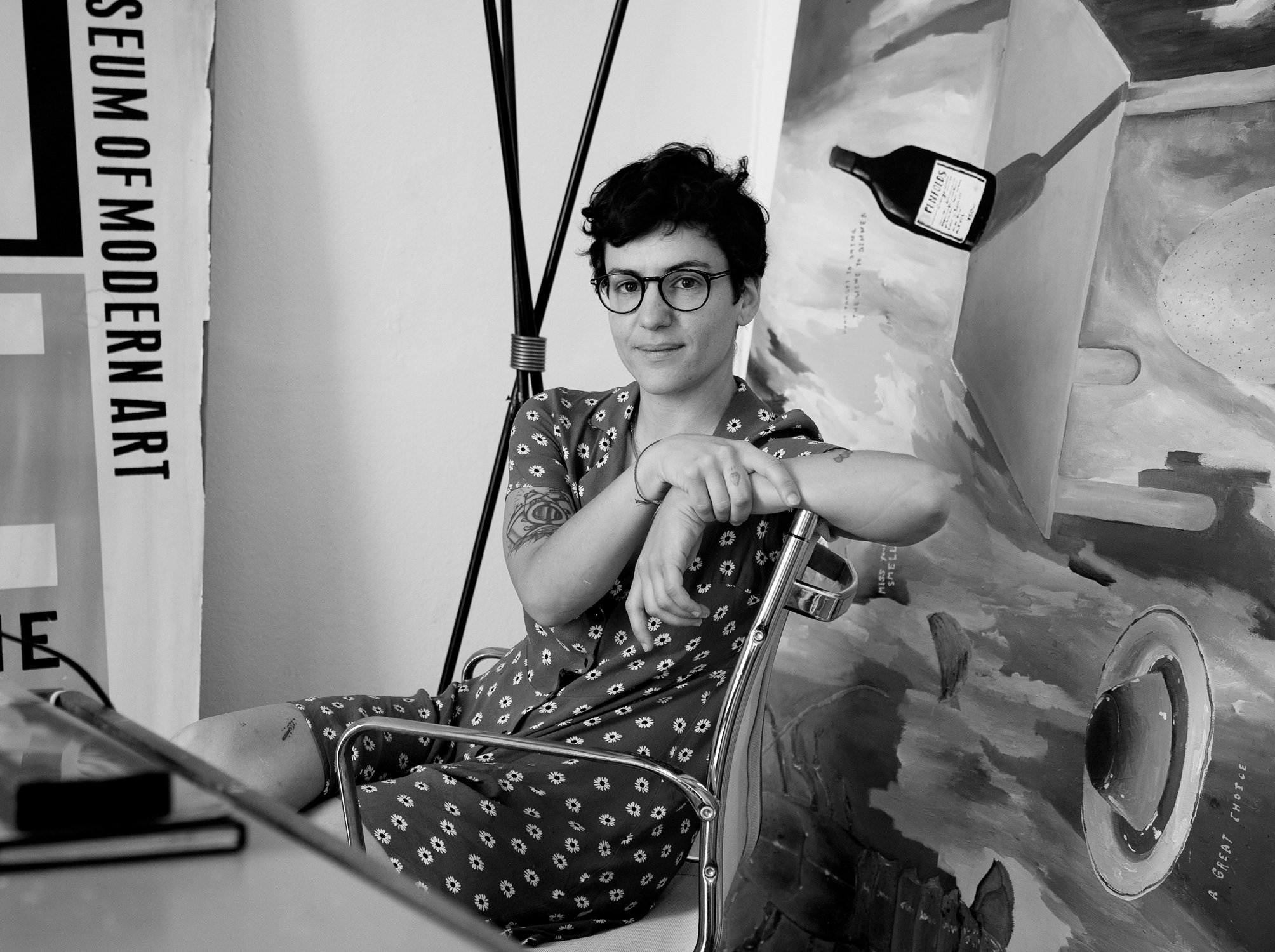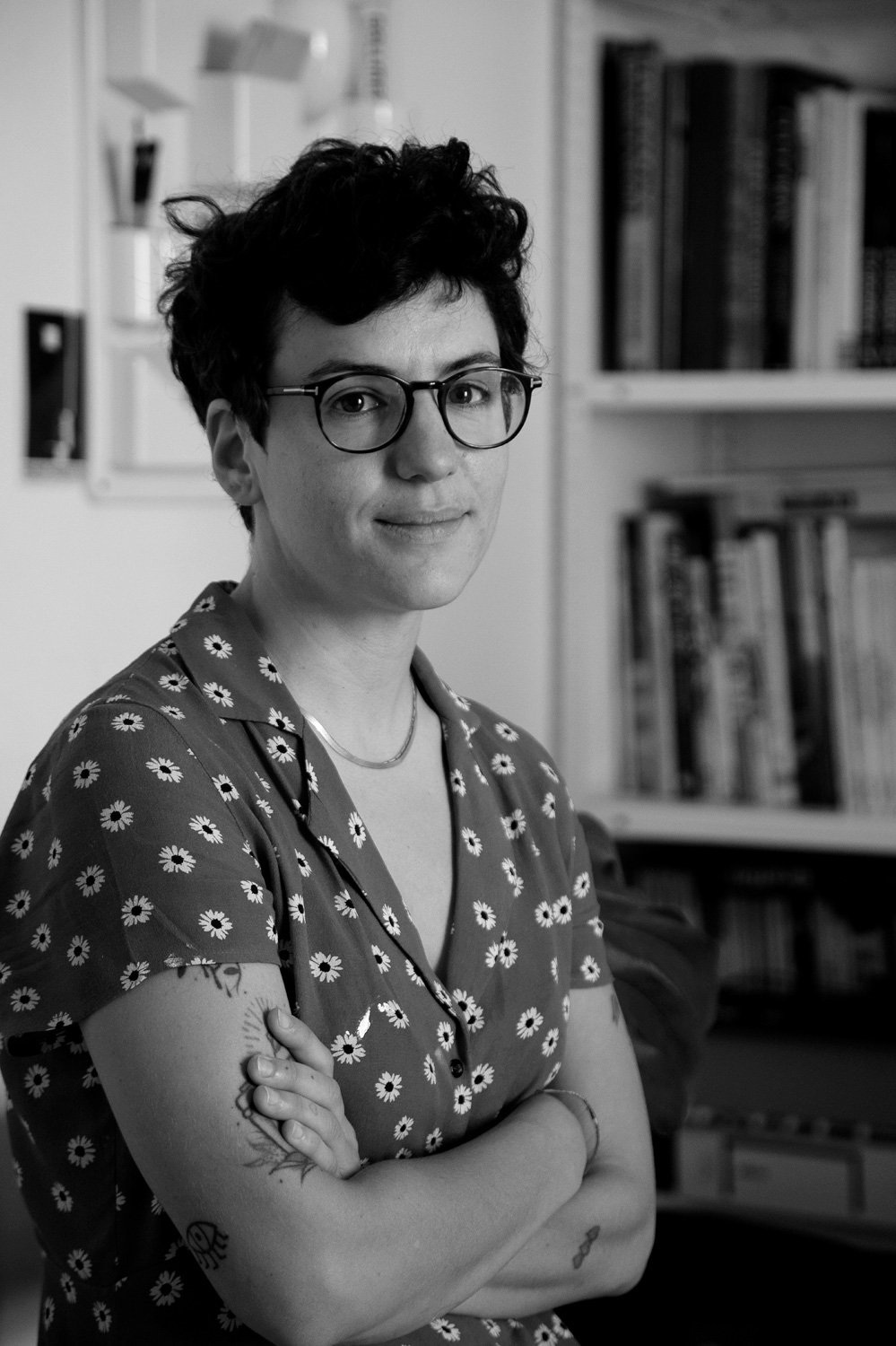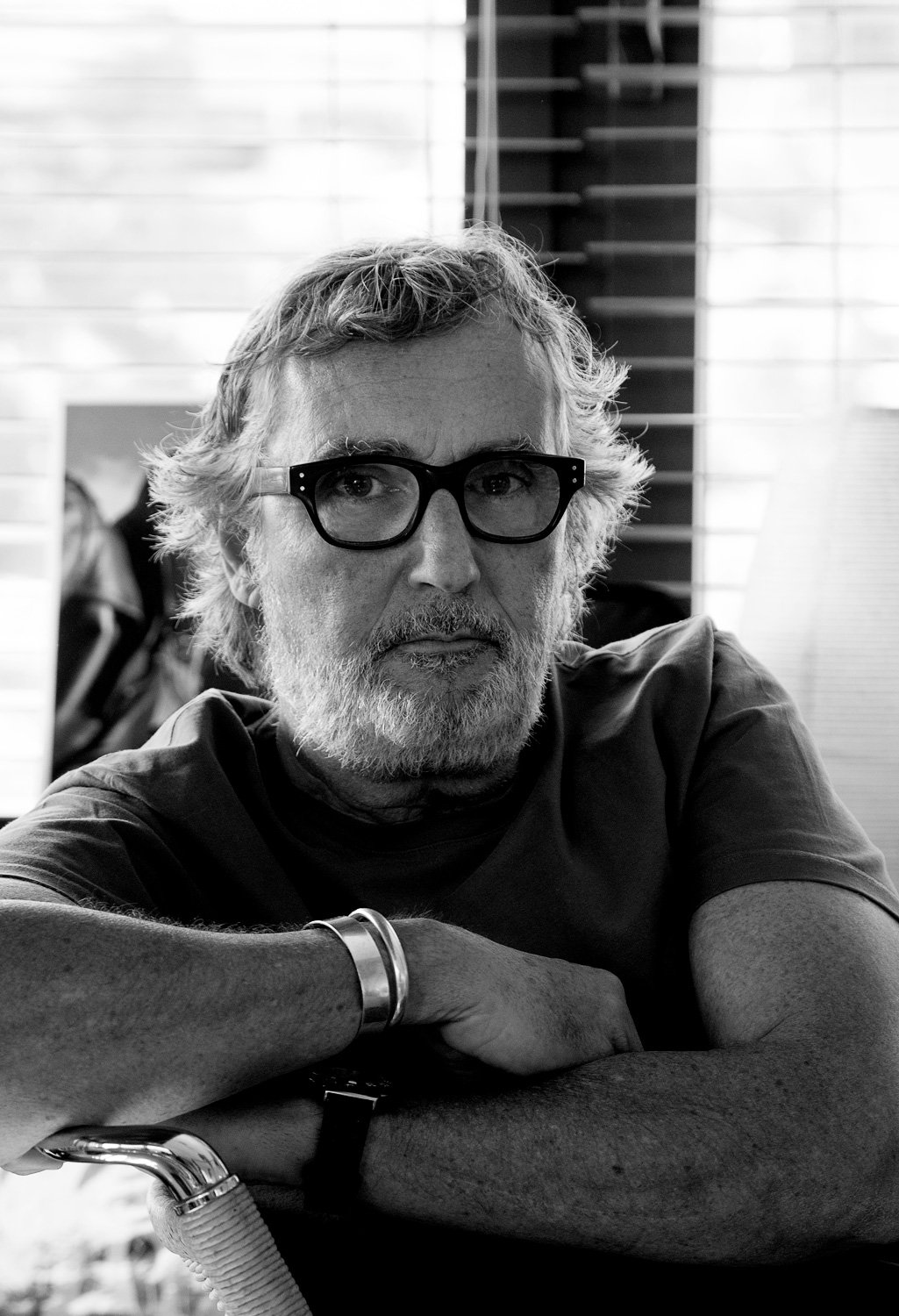Diari d’Andorra publishes an interview with Perico Pastor illustrated by one of the photographs I took of him last March.
Photographer Adriana Eskenazi, for the "Barcelona Valors afegits" project /
I wanted to portray Adriana Eskenazi since I discovered her pictorial work, which fascinated me. Later, seeing her portfolio, I realized that she is an excellent photographer. We met at her studio in Ciutat Vella, a space flooded with light and the nice colors of her paintings. Adriana talks enthusiastically about her work, about how she tries to combine painting with photography assignments, because when she starts painting she can't stop until she finishes.
In 2021 she published Amar, a visual history that she cultivated during the five years of her relationship with her partner.
Now she is preparing another book with the discarded photos of the work she does for Erika Lust, a feminist film director for adults. Those are photos that are not commercial enough for the production company and are too explicit to post on social media. Looking forward to seeing the finished book....
Adriana Eskenazi founded with Laura Encursiva the photography and filmmaking studio eskenaziencursiva in 2010. For several years they worked for production companies such as Canada and Puente Aéreo (by which they were represented until the dissipation of the production company) and for brands such as Aperol Spritz, Tampax, Massimo Dutti, Gigi Studios, Fun Factory, Bimanán, Sony Music... In 2019 Adriana Eskenazi starts working separately as well, keeping her collaboration with Laura for some projects. This independence allows her to acquire a more personal point in her creativity and she explores different artistic fields that she sometimes incorporates in her photography. Among Adriana's clients are Skoda, Oysho, Pull & Bear, Massimo Dutti, Erika Lust or the Barcelona City Council. In 2020 she starts painting around the theme of food, making commissioned works and collaborating with restaurants and wineries.
Cultural manager SILVIA OMEDES for Barcelona Valors afegits /
From Photographic Social Vision, Silvia Omedes and her team work for the defense of documentary photography and photojournalism as a tool to understand the world and promote social change. We met at the headquarters of the Photographic Foundation, an unusual and cozy house with a garden, in the Via Augusta. We talked for a while about photography, photobooks, authors and works, and about the Foundation's valuable commitment. Silvia is a close interlocutor, with an open and pleasant attitude. We could spend hours talking and we would probably still have a lot of topics to discuss.
Independent curator, cultural manager, photographers’ agent, editor, and professor of documentary photography, Silvia Omedes has been the director of Photographic Social Vision Foundation since 2001 in Barcelona. She began her career working as exhibition coordinator at the Guggenheim Museum in New York. As a visual editor, she has worked for the publishing house Blume and the magazines OjodePez. She combines visiting lectures on documentary photography in different private and public schools in Spain with the creation of alternative photography projects that challenge our society and shed light and create awareness of social issues worldwide.
She has taught at the Gris Art School in Barcelona, at IDEP, the IEFC, at EFTI in Madrid and at the Masterclasses organized by the World Press Photo Foundation in Europe and Latin America. She has been a jury for the 2015 and 2017 FNAC Young Talent awards, the LUX awards, the POY Latam awards and the 2020 Luis Valtueña Award. She is a nominee of young talent for the Joop Swart Masterclass scholarships in Amsterdam, for the Incipiens Albert Camus scholarship and for Leica’s Award (LOBA Award). In 2018 she was Secretary of the Jury of the World Press Photo Awards in Holland.
As a photographer agent, she offers consulting services to both individual authors and collections, providing better management skills and strategies for the professional exploitation of photographic archives. Her clients include the first woman photojournalist in Spain, Joana Biarnés, and the heirs of the Jácques Léonard Family Archive. Since 2014 she is a member of the Impulse Commission for the National Photography Plan of Government of Catalonia.
Àlex Susanna, writer, teacher, poet and cultural promoter. New portrait for Barcelona V. A. /
Àlex and I used to go to school together and afterwards we lost track until many years later, when he was director of the Ramon Llull Institute and we met in a reunion. Now he welcomes me at the Espais Volart of the Vila Casas Foundation, of which he is the art director.
While I prepare the camera we talk about art and artists, photography, painting, the poor acceptance of figurative painting today, how the auction houses have caused the crisis of the galleries, a little bit of everything, in the short time I can steal from his tight schedule.
Àlex speaks slowly, with measured words, with an erudite touch and with the confidence that his impressive trajectory gives him.
Àlex Susanna is a writer, teacher, poet and cultural promoter.
He has been professor of Catalan literature at the Universitat Rovira i Virgili, founder and director of Editorial Columna, Columna Música, and the International Poetry Festival of Barcelona. He has co-directed the collection of novels El Cercle de Viena, in Viena Ediciones. Subsequently he has been director of the Caixa Catalunya Foundation, director of Culture of the Obra Social de CatalunyaCaixa in La Pedrera, director of the Ramon Llull Institute and of the Catalan Agency of Cultural Heritage. In 2020 he joined the Vila Casas Foundation as art director.
He holds a degree in Catalan Philology from the University of Barcelona. He has published a number of poetry books, including Memòria del cos (1980, Miquel de Palol Prize 1979). As a prose writer, he has published Quadern venecià (1989, Premi Josep Pla 1988), Quadern de Fornells, Quadern d’ombres and Quadern dels marges.
As an art critic he has published numerous texts for catalogs and articles on exhibitions. Among his translations stand out those of Monsieur Teste by Paul Valéry (1980, Serra d’Or Critics' Prize 1981), Quatre Quartets by T.S. Eliot (1984 and 2011) and Cal·ligrames by Apollinaire, and he has also collaborated as an article writer in various media.
His work has been translated into eleven languages.
He is a member of the European Academy of Poetry.
A new portrait for "Barcelona, valors afegits: Clara S. Prous, illustrator /
As she still doesn't have a studio, Clara prefers to meet me at the bar around the corner for the photo shoot. I confess that it's hard for me to get into her universe, probably because of generational issues, but I'm very attracted to her work, which I discovered by chance on Instagram. We talk about techniques, materials and art props. She tells me that lately he is exhibiting quite a lot in small galleries and concept stores in the city. She sells originals and prints, and is increasingly in demand. She explains that people say she paints distorted characters, as if they were from Chernobyl. We agree that it is precisely in these distortions that the power of her work is based, which can indeed have Soviet but also American connotations.
"I was born in Barcelona in 1991, and I have only changed city once, and I came back.
I am an illustrator and post producer. I usually spend my days painting in my studio, although if I'm asked I edit a video or collaborate in fanzines and comics. If I'm asked to do some 3D modeling, then I charge for it. As I have a huge complication to express myself in some way, and my virtues do not include singing, I have dedicated my whole life to explore new artistic methods. That's why I studied illustration in 2014 at the Industrial School of Barcelona, and then I did a specialization course in post-production at the Espai School, also in Barcelona.
In 2018 I went to live in Liège, near Brussels, to work in a 3D studio, where I did architectural renderings. The job was good, but it was hard for me to live in -6 °C, to be honest.
When I came back home I decided what I wanted to do always was to paint, and this is what I actually do daily."
Film director Félix Fernández de Castro, new portrait for "Barcelona valors afegits" /
I met Félix when he came home to shoot a scene of the film María y yo, and later, in a long ellipsis, we met again at Gallardo's house, a few days before his death. Our relationship therefore turns around our friendship with Miguel Gallardo and we talked about him for a long time, with deep longing and feeling, and about María y yo, of course. As a good filmmaker, Felix likes to explain things in detail, and when he talks about his film, he also adds a lot of passion. You can tell he loves his work.
At the end of the session we discovered that when we were kids we went to the same school, a few years apart, sharing teachers and similar experiences. And in case there were any doubts, seeing the photograph of Martin Parr that he has hanging in the studio, and afterwards when he tells me that yes, the beautiful Triumph on the street is indeed his, we have just connected completely.
Born in 1963, Félix Fernández de Castro has spent most of his life working in advertising.
First, as a creative in different agencies in Barcelona, where he has held all positions, from junior copywriter in the first one to creative director and founding partner in the last one, SCPF...
And then, more than two decades ago, as a filmmaker. Since 2017, at his own production company, Blank films. On both sides of the camera, his work has been recognized with almost all the advertising awards that exist.
In 2010 he shot the film María y yo, a film adaptation of Miguel Gallardo's graphic novel of the same title.
He has two and a half children, two dogs and two cats, with whom he lives intermittently in a house in the mountains of Collserola, north of Barcelona. He likes cooking, baking bread, and if he had not been a director, he would have loved to be a musician or a carpenter.
One more portrait: great great artist, Marcos Palazzi. /
I meet Marcos Palazzi in his studio, an old factory in the Rivera neighborhood. He is a fascinating personage, like his paintings that cover the walls of the studio. As we talk, he writes down on a piece of paper names and information that come up during the conversation. Palazzi's work is so powerful that it is hard to understand why he does not have greater recognition. He himself speaks of his work with excessive modesty. A great lover of comics, he tells me that our well-remembered mutual friend Gallardo asked him why he did not draw comics, and he tells me "but I have nothing to explain!". I point out to him, incredulous, his magnificent paintings. "Okay, yes, all right," he replies, "but this is something else..."
Marcos Palazzi is a figurative painter of portraits and scenes of the unusual and the ordinary. His characters live absurd situations in environments where details, apparently irrelevant, become fascinating and even humorous.
As he himself explains: "I was always drawing with a pencil and I started painting at the age of eighteen when I entered at EINA school thanks to one of my teachers, Serra de Rivera. I entered EINA with the idea of doing design but I soon switched to art. Afterwards I enrolled at La Massana and later at La Llotja. In all the schools I went through I had very good teachers. I also liked comics and I loved going to exhibitions and museums like the old MNAC, which was in La Ciutadella. There I got immersed in painting. I was alone and I would spend hours in front of a painting.
I don't know how to define my art. It's quite similar to the music I listen to and the books I read. I can say it's a bit eclectic. I like to vary the classical look on what surrounds me. Light is key. I like artificial light and I put the focus on what I want to show."
Since 1992 he has exhibited in Barcelona, Bologna, Berlin, Centelles, Geneva, Girona, London, Madrid, Milan, Monaco, New York, Reus, Sant Cugat, Santiago de Chile, Zaragoza, Tarragona.
Toni Casares, for "Barcelona valors afegits" /
I haven't seen Toni for a long time, I think since he came on vacation when I was living in Montreal, in 1997. I find him unchanged and very enthusiastic, as always, about theater. He welcomes me at the flamboyant Sala Beckett, in Poble Nou, an unquestionable reference point for theater in Barcelona. As he shows me around the facilities I realize how passionate he is about it and how lucky he feels to be doing his job. I tell him, apologizing, that I rarely go to the theater, almost never, in line with the reasons given by Quim Monzó in his famous talk Why I don't go to the theater, and he answers that he likes the theater precisely for the same reasons that Monzó doesn't like it.
Toni Casares is the director of the Sala Beckett/Obrador Internacional de Dramaturgia. With a degree in Catalan Philology from the UAB and a postgraduate degree in Theory and Criticism of Theatre Performance, he was a founding member of the UAB's Theatre Classroom, of which he was artistic director from 1992 to 2004, as well as head of the university's Live Culture Program.
Between 1989 and 1992 he was General Coordinator of the Centre Dramàtic de la Generalitat de Catalunya. In 1997 he took over the direction of the Sala Beckett in Barcelona, to which he had been linked since its foundation.
He has directed shows of international contemporary authorship, with special attention to Catalan authorship, with texts by Sergi Belbel, J.M. Benet y Jornet, Martin Crimp, Pau Miró, Mercè Rodoreda, Mercè Sarrias, Roland Schimmelpfennig, or Fréderic Sonntag, among others. He is the author of Aquí s’aprèn poca cosa, the theatrical adaptation of the novel Jakob Von Guntten, by Robert Walser.
(Between 2005 and 2012 he was a member of the Advisory Council of the National Theater of Catalonia, and between 2011 and 2016, a member of the executive committee of the Barcelona Culture Council. He is currently a member of the Advisory Council for the Performing Arts of the Ministry of Culture).
Lucia Fumero, a great artist portrait for "Barcelona valors afegits" /
Lucia's flat, in the Sants neighbourhood, is a small oasis where the sunshine breaks through and seems to come from somewhere else. In the midst of an almost harmonious disorder, she composes and performs her pieces, surrounded by plants and her cats Tofu and Mora. On a music stand I see the score of Radio Rewrite by Steve Reich. She tells me that she is studying this piece to conduct it soon at the Barcelona Auditorium.
With an enviable vitality and a contagious smile, she explains to me how she went to Holland, where she studied world music, perhaps in an unconscious reflex to seek something beyond jazz, which is already part of her DNA. And how she later came back to Barcelona, where she continued studying at the ESMUC, mostly - she explains - to get to know other musicians. And since then she hasn't stopped, playing with the best musicians and composing wonders like her latest album, Universo normal. In her own words, "Universo normal is a door to my imagination. That's why it's normal. And that's why it's a universe. It's a concept that inspires magic, something huge like the universe, but at the same time concentrates on something very basic, rootsy, like folk music. "
Lucia Fumero is a pianist and singer born in Barcelona, with Argentinian and Swiss roots. She began studying classical music at the Municipal Conservatory of Barcelona, where she graduated with the Grado Profesional de Música in 2010. She then travelled to Holland to continue studying and working. There, at the Rotterdam University of Music, she studied a higher degree in modern music specialising in Latin music. She is now in her final year at the ESMUC specialising in jazz piano. She has participated as a musician in many different ensembles of different styles and has released her first album with original music. She often collaborates with the new generation of Barcelona musicians such as Rita Payés, Nico Roig, Pol Batller and Martín Meléndez, among others.
Portraying Cristina Blanch for "Barcelona valors afegits". /
Cristina welcomes me at her studio, which is also her art school. An apartment in the Gracia district, full of hidden and charming spaces. We talk about Barcelona, about artists and galleries, and about her work. I observe the elegance of her movements and the attractive mix of irony and self-assurance she has when she talks. She tells me that she likes to paint watercolors more than oil paintings and shows me some magnificent portraits in small format. I admire her oil paintings, which are also very good, often resolved with unexpected resources. She tells me how, for her latest project, she gets her inspiration from listening to crime podcasts in order to imagine and recreate the scenarios: mysterious houses lost in the middle of nowhere.
Cristina Blanch studied art at the ESAG Penninghen in Paris. Creator and director of the Blanch Art School, founded in 1990 in Barcelona, she has developed in parallel her activity as a painter with exhibitions in Barcelona, Madrid, Italy, Hong Kong and Singapore.
















